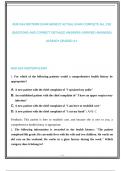NUR 634 MIDTERM EXAM NEWEST ACTUAL EXAM COMPLETE ALL 100
QUESTIONS AND CORRECT DETAILED ANSWERS (VERIFIED ANSWERS)
ALREADY GRADED A+
NUR 634 MIDTERM EXAM
1. For which of the following patients would a comprehensive health history be
appropriate?
A. A new patient with the chief complaint of "I sprained my ankle"
B. An established patient with the chief complaint of "I have an upper respira-tory
infection"
C. A new patient with the chief complaint of "I am here to establish care"
D. A new patient with the chief complaint of "I cut my hand": ANS: C
Feedback: This patient is here to establish care, and because she is new to you, a
comprehensive health history is appropriate.
2. The following information is recorded in the health history: "The patient
completed 8th grade. He currently lives with his wife and two children. He works on
old cars on the weekend. He works in a glass factory during the week." Which
category does it belong to?
,A. Chief complaint
B. Present illness
C. Personal and social history
D. Review of systems: ANS: C
Feedback: Personal and social history information includes educational level, family of
origin, current household status, personal interests, employment, religious beliefs,
military history, and lifestyle (including diet and exercise habits; use of alcohol, tobacco,
and/or drugs; and sexual preferences and history). All of this information is documented
in this example
3. Mrs. Hill is a 28-year-old African-American with a history of SLE (systemic lupus
erythematosus). She has noticed a raised, dark red rash on her legs. When you press
on the rash, it doesn't blanch. What would you tell her regarding her rash?
A. It is likely to be related to her lupus.
B. It is likely to be related to an exposure to a chemical.
C. It is likely to be related to an allergic reaction.
D. It should not cause any problems.: ANS: A
Feedback: A "palpable purpura" is usually associated with a vasculitis. This is an
inflammatory condition of the blood vessels often associated with systemic rheumatic
disease. It can cut off circulation to any portion of the body and can mimic many other
diseases in this manner. While allergic and chemical exposures may be a possible cause
of the rash, this patient's SLE should make you consider vasculitis 4. Two weeks ago,
Mary started a job which requires carrying 40-pound buckets. She presents with
elbow pain worse on the right. On examination, it hurts her elbows to dorsiflex her
,hands against resistance when her palms face the floor. What condition does she
have?
A. Medial epicondylitis (golfer's elbow)
B. Olecranon bursitis
C. Lateral epicondylitis (tennis elbow)
D. Supracondylar fracture: ANS: C
Feedback: Mary's injury probably occurred by lifting heavy buckets with her palms down
(toward the bucket). This caused her chronic overuse injury at the lateral epicondyle.
Medial epicondylitis has reproducible pain when palmar flexion against resistance is
performed and also features tenderness over the involved epicondyle. Olecranon bursitis
produces erythema and swelling over the olecranon process. A supracondylar fracture of
the humerus is a major injury and would present more acutely.
5. Mrs. T. comes for her regular visit to the clinic. She is on your schedule because
her regular provider is on vacation, and she wanted to be seen. You have heard
about her many times from your colleague and are aware that she is a very talkative
person. Which of the following is a helpful technique to improve the quality of the
interview for both the provider and the patient?
A. Allow the patient to speak uninterrupted for the duration of the appointment.
B. Briefly summarize what you heard from the patient in the first 5 minutes and
then try to have her focus on one aspect of what she told you.
C. Set the time limit at the beginning of the interview and stick with it, no matter
what occurs in the course of the interview.
D. Allow your impatience to show so that the patient picks up on your nonver-bal
cue that the appointment needs to end.: ANS: B
, Feedback: You can also say, "I want to make sure I take good care of this problem
because it is very important. We may need to talk about the others at the next
appointment. Is that okay with you?" This is a technique that can help you to change the
subject but, at the same time, validate the patient's concerns; it also can provide more
structure to the interview
6. You feel a small mass that you think is a lymph node. It is mobile in both the up-
and-down and side-to-side directions. Which of the following is most likely?
A. Cancer
B. Lymph node
C. Deep scar
D. Muscle: ANS: B
Feedback: A useful maneuver for discerning lymph nodes from other masses in the neck
is to check for their mobility in all directions. Many other masses are mobile in only two
directions. Cancerous masses may also be "fixed," or immobile
7. A 77-year-old retired bus driver comes to your clinic for a physical examination
at his wife's request. He has recently been losing weight and has felt very fatigued.
He has had no chest pain, shortness of breath, nausea, vomiting, or fever. His past
medical history includes colon cancer, for which he had surgery, and arthritis. He
has been married for over 40 years. He denies any tobacco or drug use and has not
drunk alcohol in over 40 years. His parents both died of cancer in their 60s. On
examination his vital signs are normal. His head, cardiac, and pulmonary
examinations are unremarkable. On abdominal examination you hear normal
bowel sounds, but when you palpate his liver it is abnormal. His rectal examination
is positive for occult blood. What further abnormality of the liver was likely found
on examination?





